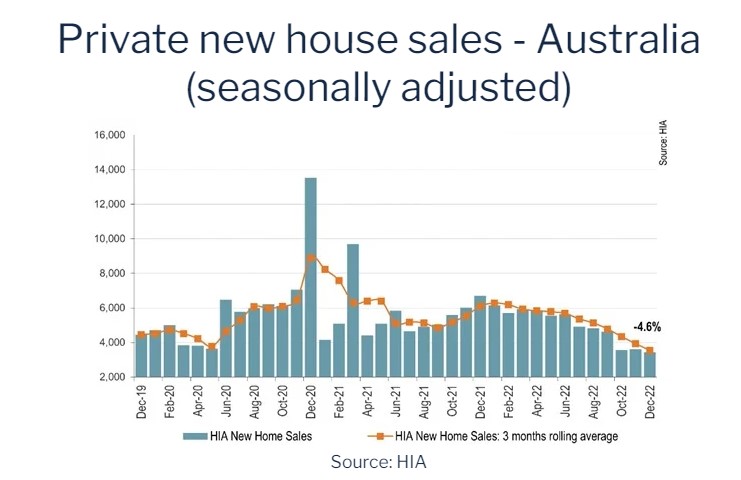Drive or dive: Assessing the risks for developers and how those risks are managed
Construction projects don’t always go as planned and sometimes projects may fall behind or incur additional unforeseen costs. The construction industry has been through a particularly challenging period since the COVID pandemic began, with supply chain issues, state-enforced shutdowns, high material costs, labour shortages and weather events are some of the factors having the biggest impact on the sector.
In this article, we explore the biggest risks facing the sector in more detail and outline some of the mitigation strategies lenders should have in place to minimise, monitor and manage borrower default risk.
Key challenges facing builders
Builders have been doing it tough over the past couple of years. One of the biggest challenges for builders has been sourcing enough materials at affordable prices, as rising material costs have been compounded by supply chain issues. Strains on logistics and delays in delivery caused a bottleneck in 2020 and 2021 during the height of the pandemic and the industry continues to be affected.
The surge in building material costs has been reflected in the Australian Bureau of Statistics’ (ABS) recently released Producer Price Indices, which showed a 5% jump in the cost of concrete, cement, and sand in the December quarter. There were even bigger surges in the cost of cupboards and built-in furniture as plywood and glass prices climbed. The report showed that overall, prices increased by 2.2% in the December quarter. This brings the annual rise in residential building material costs to more than 14 per cent, a significant annual increase. However, the 2.2% rise over the quarter was lower than previous quarterly price increases, which could indicate the trend is slowing, and is a positive sign.

The increasing costs associated with the Australian property market have presented builders with cash flow challenges because many are locked into fixed-price contracts with clients. In the rapidly inflationary environment, builders are finding it particularly difficult to ensure profit is maintained.
Additionally, labour shortages and border closures in the property market, exacerbated by the pandemic, have resulted in a struggle to source adequate labour at affordable rates. This in turn has resulted in unfinished builds or significantly delayed builds, hurting profit margins. Although a labour shortage remains, CoreLogic points out that the property market outlook is optimistic, with the opening of borders and the arrival of skilled workers expected to eventually flow through to the construction industry.
Key challenges facing developers
In the current market, external risks and challenges are making it more difficult for property developers to achieve their expected return on investment. The pandemic presented a tough and unpredictable period for developers. With rising interest rates, volatile asset valuations and fears of housing market corrections, developers are now facing increasing cash flow challenges. In some instances, completed products are not being sold or have suffered from price deterioration, while in other instances, developers are facing the prospect of projects not being completed by the builder due to the issues outlined above.
The latest figures from the Housing Industry Association (HIA) show sales of new homes dropped 4.6 per cent in December and were down 42 per cent on the previous year. The slowing in sales is expected to cause a slowdown in building activity in the second half of 2023, according to HIA chief economist Tim Reardon.

In Australian property news, we are currently experiencing a shortage of housing and new supply, alongside record low vacancy rates, high rental returns, record employment rates and increasing wages. The Albanese Government has increased the planning level for the 2022-23 Migration Program, meaning demand for new dwellings in the country will increase further. With skilled migration ramping up though, CoreLogic predicts that costs associated with some trades and labour will slow, reducing some of the pressure on the industry.
More than ever, developers need to think about timing, the needs of the end buyer and hitting the market at the right time. Developers that are more risk averse and more tuned into that risk are more likely to make it through the ups and downs in the market.
It is worth noting that the sector’s ability to adapt to changing circumstances underlines positivity and upbeat sentiment about the future—particularly in the longer term.
Investing in this space presents potential for higher returns if you align with your risk profile
Australian real estate offers a compelling investment opportunity globally, with a strong economy, stable returns, high liquidity, a focus on ESG and potential for future growth.
Mortgage funds with a strong emphasis on quality have long been seen as a valuable asset class, offering the potential to earn income and the security of a diversified property portfolio supporting income-generating mortgages.
In the absence of strong investment risk management and a focus on diversity in portfolio construction, the stability of some mortgage funds will be challenged in the face of increased debt pressure. Mortgage funds that focus on disciplined risk management and diversification tend to have a low loan in default rate due to the quality of the underlying properties, spread of lending across different categories and regions, and the financial strength and proven track record of borrowers and developers Well-managed portfolios can continue to deliver the income typically associated with the sector, while appropriately managing the risk and weathering any pressure from market conditions.
Regardless of the type of fund, investment criteria or return rate, investors should always prioritise a well-managed and consistently performing mortgage fund with a strong rating.
Furthermore, there is no substitute for high quality advice from a licenced financial planner. Financial planners have the infrastructure and expertise to differentiate between various mortgage (and other) funds, understand management styles and product risk, and also how to match investments against the needs and risk appetite of the investor.
It is important to evaluate the fund manager, their organisation’s experience and dedication, resources invested in the fund, loan security, portfolio diversification and investment risk management methods used. Investors should have confidence in the product’s style and the manager’s ability to consistently deliver well-managed, high-performing products.
Lenders must have mitigation strategies in place to protect against builders and developers defaulting
Managing risk is essential and at Trilogy Funds, we prioritise risk management, working hard to protect our investors’ funds and ensure the projects we fund are supported through to completion.
To help ensure that we provide loans to capable borrowers and projects, loan proposals are assessed by our Lending Committee—a seasoned group with experience in law, quantity surveying and project management, and financial services.
Loans supported by the Trust have the following features:
- A registered first mortgage for security
- A maximum loan-to-value ratio of 70% based on the as-is or as-if-complete value, depending on the loan
- An independent, qualified valuer determining the asset values at the time of loan submission
- Clear and defined loan repayment strategies
- Prohibition of related party lending
- Mandatory insurance coverage for the property
In addition to these quantitative factors, the Lending Committee also evaluates qualitative elements such as the borrower’s prior experience with similar projects, the quality of project management, delivery, sales and marketing plans, as well as their resources and capacity to successfully complete the project.
If we choose to provide a loan, we aim to have it structured and resourced appropriately. Our funding packages are tailored to meet the specific needs of each project, incorporating contingencies to help offset potential delays or challenges, such as supply chain interruptions or increased material and labour costs.
Our borrowers are supported from loan inception to successful completion and repayment by a dedicated lending manager and we offer indicative loan offers typically within 48 hours.
Learn more about Trilogy
Trilogy is one of Australia’s leading fund managers of property-based investments. For over 22 years, seeking income and managing risk on behalf of thousands of investors has remained at the heart of everything we do. Find out more here.

1 fund mentioned

